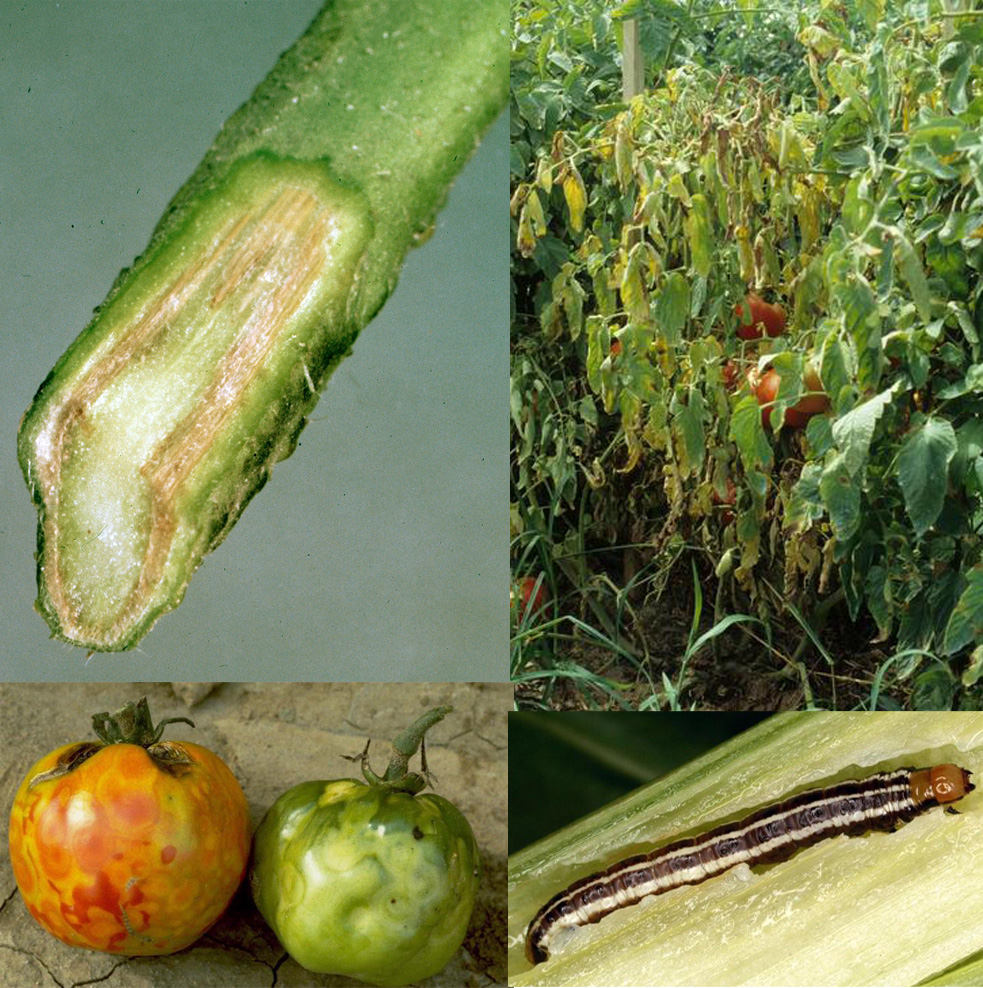
By Sarah Browning, Extension Educator in Lancaster County
Nothing is more disappointing to the home vegetable gardener than to raise a tomato plant, finally have it loaded with fruit, when suddenly it wilts and dies. What could be the problem? Possible causes include lack of water, fungal wilt diseases, tomato spotted wilt virus, walnut toxicity and stalk borers.
LACK OF WATER
Tomato plants require approximately one inch of water per week. Plants may wilt badly when soils are dry, but will revive rapidly when they are watered. A thorough watering once a week during hot, dry weather should be sufficient. Apply water directly to the soil around the base of the plants with a garden or soaker hose. If an overhead sprinkler is used to water the tomatoes, water the plants in the morning to reduce foliar disease problems.
FUNGAL WILT DISEASES
Verticillium and Fusarium wilt are two common diseases that affect tomatoes and plants in the tomato family, such as pepper, eggplant and potato. Both diseases overwinter as fungal spores in garden soil or on infected plant debris that was not discarded at the end of the previous growing season. Spores enter the plant through the roots. The fungus then grows up into the main plant and throughout the plant’s vascular system, blocking the movement of water and nutrients. As water movement to the leaves stops, they begin to turn yellow and wilt.
Plants can be infected at any stage of growth. Young plants may completely wilt and die soon after planting. The first symptoms on older plants appear when leaves, either at the top or bottom of the plant, wilt during the day, and then recover at night. Eventually, infected plants no longer recover at night, but remain permanently wilted and finally die. Stems of infected plants show brown streaking within the vascular tissues just under the green outer tissue. Infected leaves turn yellow, wilt and die. There is no cure for fungal wilt diseases, so infected plants should be removed and discarded, but do not place diseased plants in the compost pile. For management recommendations, read “Verticillium Wilt of Tomato and Eggplant,” NC State Extension, https://bit.ly/verticillium.
TOMATO SPOTTED WILT VIRUS (TSWV)
TSWV causes stunting, wilting, bronzing of foliage and brown or green rings on fruit. A virus disease, TSWV can infect plants in the greenhouse or in the field. Infected plants cannot be cured and should be removed from the garden. Use resistant tomato varieties in gardens with a history of this disease. For more information, read “Tomato Spotted Wilt Virus,” South Dakota State University Extension at https://bit.ly/tsw-virus.
WALNUT TOXICITY
Black walnut trees produce a toxic material (juglone) that can injure and kill solanaceous crops (tomatoes, potatoes, peppers and eggplant) and other juglone-sensitive vegetables in the garden. Symptoms of walnut toxicity include stunted growth, yellowing and wilting of foliage and death of susceptible plants. Juglone is present in all parts of the black walnut tree (fruits, leaves, branches and roots). Generally, the greatest concentration of juglone in the soil exists within the dripline of walnut trees.
Nothing can be done to save juglone-damaged tomato plants. Simply remove and destroy dead plants. Gardeners who have large walnut trees near their gardens should consider alternate sites. If alternate sites are unavailable, plant tomatoes and other susceptible plants 20–25 feet beyond the dripline of walnut trees to minimize walnut toxicity problems.
Corn, beans, onions, beets and carrots are tolerant of juglone and can be planted closer to walnut trees provided the area receives sufficient sunlight. Walnut trees that are 75–100 feet from the garden shouldn’t be a big threat to tomatoes and other juglone-sensitive vegetables.
STALK BORERS
The stalk borer is an insect pest that attacks a wide variety of plants including tomatoes. The larva (caterpillar) bores into the stem and tunnels inside the stalk. (The entrance hole is small and often difficult to locate). Affected plants wilt and often die. However, stalk borer damaged plants that are given good care may survive.
Tomato plants that die should be pulled and destroyed. The destruction of the plants may also kill the stalk borer. Cutting or mowing tall weedy areas around vegetable gardens may also help control the pest.
For more information, read “Common Stalk Borer” from Kansas State Research and Extension at https://bit.ly/stalk-borer.